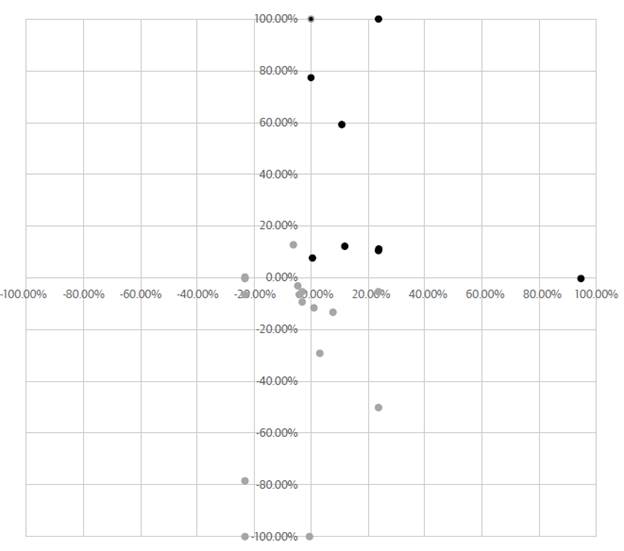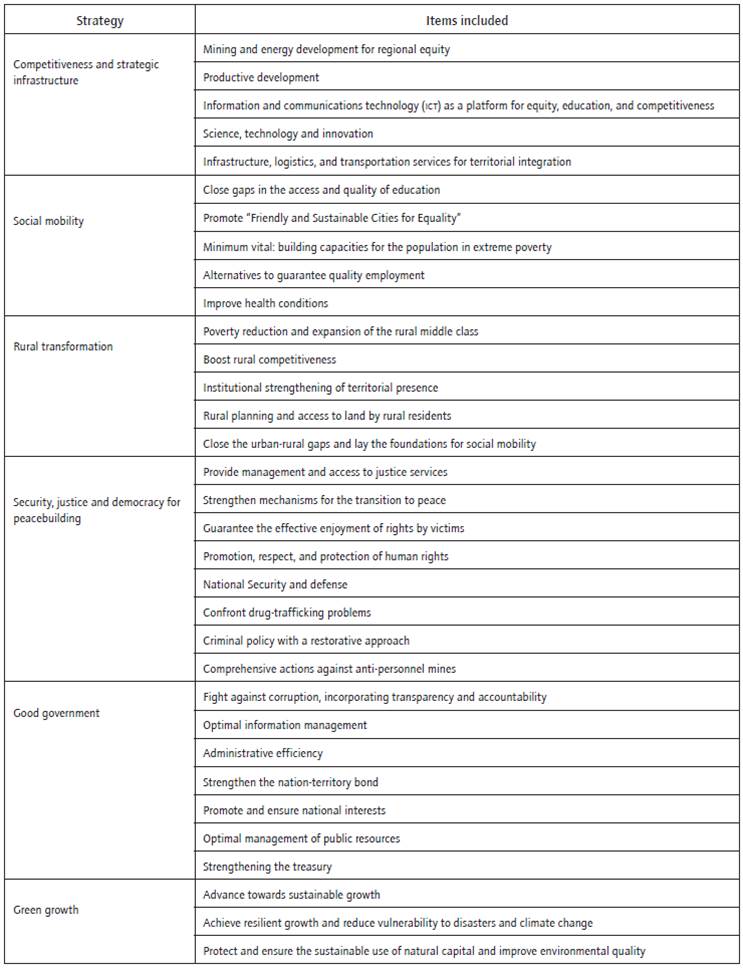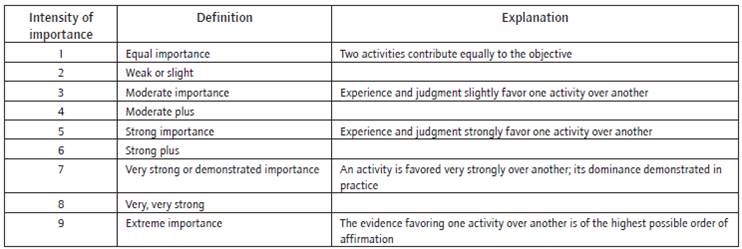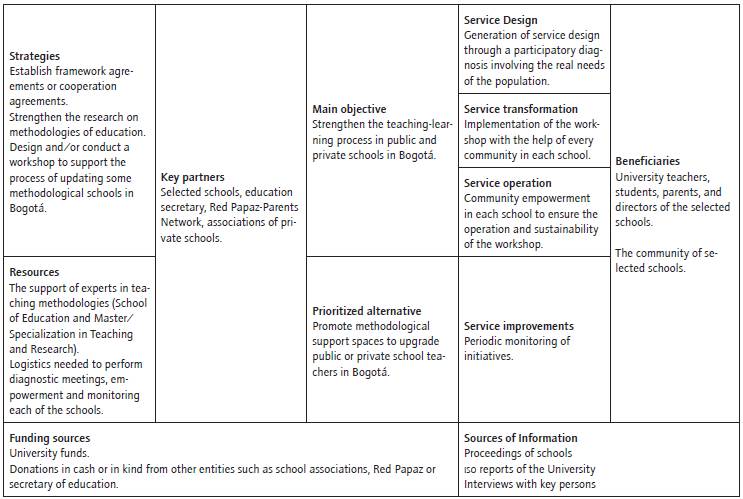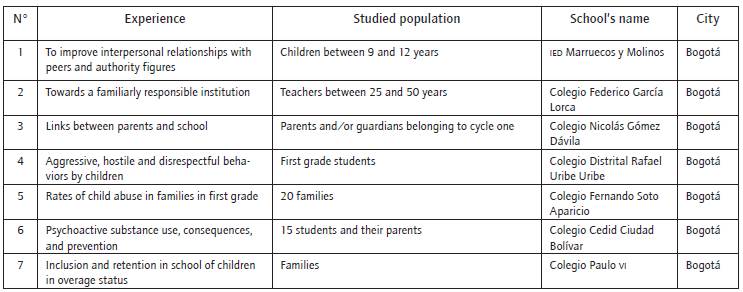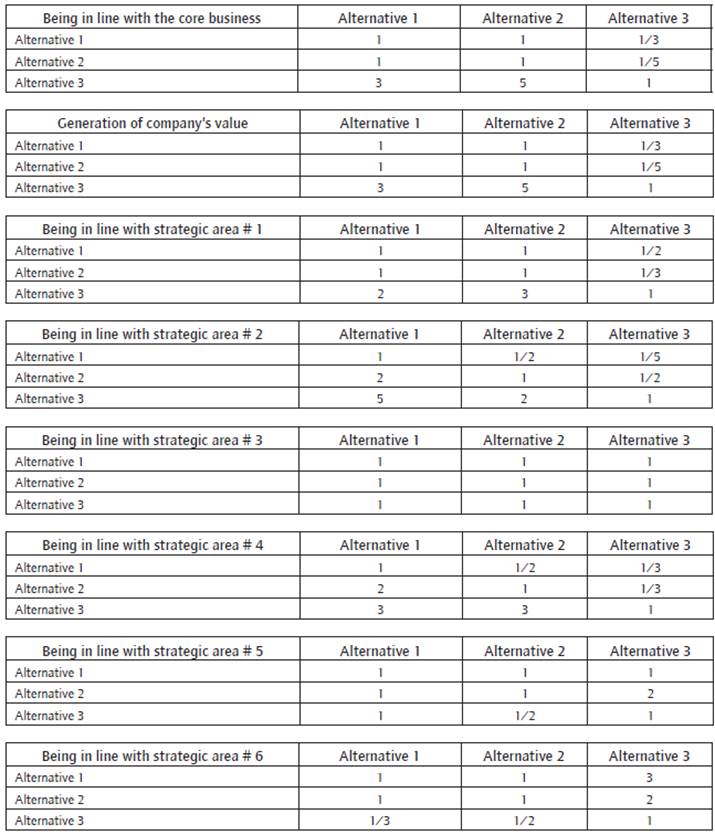Introduction
Companies are increasingly interested in implementing new strategies to improve corporate governance and new managerial structures in an effort to foster social welfare. Some authors have presented the relationship between innovation and Corporate Social Responsibility (CSR) as a strategy to improve an organization's environment (Boubakary & Moskolaï, 2016; Gallego, Prado, & García, 2011; Martínez-Martínez, Herrera-Madueño, Larrán, & Lechuga-Sancho, 2017; Porter & Kramer, 2006). In this sense, CSR has also become a global phenomenon and gained an important place in the corporate agenda (Barrena-Martínez, López-Fernández, & Romero-Fernández, 2016; González, 2008). This global trend is also present in Colombia, where CSR development has been increasing in recent years, although in smaller proportions (Giraldo-Cardenas, Kammerer, & Ríos-Osorio, 2016; López, Quiroga, López, & Torres, 2006; Niño-Muñoz, 2015; Peña, Serra, & Cardona, 2017). The same tendency is observed in the Colombian higher education environment. As an example, the University Social Responsibility Observatory was founded in 2007 with the support of UNESCO International Institute for Higher Education in Latin America and the Caribbean (IESALC). Now, it is linked with IELSALC Social Responsibility Regional Centre for Latin America and the Caribbean (ORSALC, in Spanish) and has 17 Colombian universities affiliated.
In current Colombian context the challenge is to promote CSR practices among organizations and to determine their scope and possibilities as a strategic tool to foster sustainable development. CSR also offers the possibility of increasing a firm's value in an ethical way. The procedures to respond to this challenge should help firms to adopt a responsible and autonomous position regarding the impacts of their actions, including, but not limited to, legal requirements or economic motivations. This means CSR is more than having a good image or acquiring a social license. Therefore, organizations have the responsibility to contribute to the common good by offering social conditions (Akrivou & Sison, 2016; Garriga & Melé, 2013).
We based our study on Sergio Arboleda University, a traditional Colombian higher education institution founded in 1984. In 2015, the University received the High Quality Accreditation certificate, the greatest educational distinction given in Colombia by the National Ministry of Education. Its mission states that the University is at the service of the comprehensive training of new professionals according to humanistic and Christian principles, who are capable of leading economic, social and cultural development. Today, it is present in three regions of the country. Its main campus is located in Bogota (the capital of Colombia) and has two additional campuses in Colombia, located in Santa Marta and Barranquilla, and two other in Madrid (Spain) and Miami (U.S.A.). Sergio Arboleda University has many initiatives to improve its stakeholders' development. Among them, the Entrepreneurship Center, the Female En-trepreneurship Center, the Research and Innovation Direction, and several projects in conjunction with the Mayor's office and the national government.
Based on the above, this paper presents a holistic solution to successfully cope with Sergio Arboleda University needs in terms of CSR practices. The present study is based on the methodology developed by Niño-Muñoz (2016), which follows a humanistic approach and strategically identifies available opportunities for a company that is established in several regions within a territory. This proposal contributes to the achievement of the new Sustainable Development Goals (SDCS) and the past Millennium Development Goals (MDCS), which are both important in the Colombian context considering current efforts to achieve peace (Jiménez, 2014). These goals also indicate an understanding of the importance of promoting human development in our country.
The research article is structured in five sections, including this introduction. Section two offers a background review on CSR methodologies in order to understand the best methodology to be applied. Section three briefly explains the methodology to identify CSR strategies with a regional focus. Section four presents the findings of this regional. In an attempt to introduce the abundant material in a practical way, results are exposed through the three main stages of the proposed method: i) Alternatives identification; ii) Prioritization; and iii) CSR strategies design. Last section presents the conclusions of this study.
Theoretical Framework
In light of Colombia's current needs, socio-economic disparities, and the internal armed conflict, organizations -especially academic institutions- have the incentive to contribute to the development of the region where they operate (Barrena-Martínez et al., 2016). Based on this point of view, CSR strategies can be an important channel to achieve human development objectives (Barrera-Duque, 2007; Schuster, Lund-Thomsen, & Kazmi, 2016; Sinkovics, Sinkovics, Hoque, & Czaban, 2015), build a culture of peace (Jiménez, 2014), and contribute to competitiveness at the national level (Boulouta & Pitelis, 2014). When CSR is part of a company's strategy it recognizes its shared responsibility with government and society towards building human development in the territory where it operates.
Thus, when corporate behavior has a strategic approach it is possible to achieve collaboration between companies, government, and other key social actors in the territory (Bair & Palpacuer, 2015).
CSR research has been experiencing a significant increase in recent years (Dahlsrud & Dahlsrud, 2008; Engert, Rauter, & Baumgartner, 2016; Lindgreen, Córdoba, Maon, & Mendoza, 2010; Volpentesta, Alcaín, Nievas, & Spinelli, 2014). It is also important to highlight the growing tendency to include CSR as part of a company's strategy (Sapién, Piñón, & Gutiérrez, 2016; Boubakary & Moskolaï, 2016; Carroll & Shabana, 2010; Engert et al,, 2016; Toro, 2006; Werther & Chandler, 2006), even in small and medium-sized enterprises (Martínez-Martínez et al., 2017).
Literature has established different approaches and theories of this concept (Argandoña, 2007; Carroll, 1999; Garriga & Melé, 2013; Niño-Muñoz, 2015; Vera-Acevedo & Peláez-Villada, 2013). Garriga and Melé (2013) present a complete review surrounding the types of CSR and the strategies that firms actually use or should adopt. Accordingly, these authors categorized CSR strategies in four basic groups: instrumental, political, integrative and ethical theories. In addition, other studies have presented different methodologies for implementing CSR as part of the business strategy (Hernández-Rodríguez, 2013; Krick, Forstater, Monaghan, & Sillanpàà, 2005; Park, Park, Hong, & Yang, 2017; Porter & Kramer, 2006; Vera-Acevedo & Peláez-Villada, 2013).
Methodologies for the identification of business behavior in social responsibility are crucial to build a company's holistic strategy (Dhaliwal, Radhakrishnan, Tsang, & Yang, 2012; Gregory & Whittaker, 2013; Rubin & Babbie, 2017). These strategies must aim for the well-being of the society and cover the entire activity of the company, i.e. its internal dimension (human resource, productivity, efficiency, and financial performance) and its external impact on society and the market. Therefore, this kind of methodologies must cover the complete value chain (Deng, Kang, & Low, 2013).
It is also important to harmonize responsibility regarding management reports (Tschopp & Nastanski, 2014; Núñez-Chicharro, Alonso-Carrillo, & Pontones, 2015), as well as the decisions on which instruments and standards will be used by the company for assessing and measuring CSR practices (Schwalb & García, 2004). However, it is frequent that these types of studies include the stakeholder approach (Isa, 2012) and the environmental, economic, and social dimensions of the company. The debate on the implementation of CSR practices and how to carry out this process has been increasing (Correa, 2007; González, Rodríguez, & González-Millán, 2014; Polanco, 2014).
From a conventional approach, these methodologies make a special emphasis on mapping stakeholders and achieve their engagement (Krick et al., 2005). Stakeholders are individuals or groups who affect or are affected by an organization and its activities, creating a bidirectional influence between them and the firm (Freeman, 2010). In this sense, in order to guarantee the survival and success of the company, stakeholder theory suggests that it is essential to meet the needs of the company's various stakeholders far beyond the exclusive interest of shareholders (Freeman, 2010). Therefore, this theory steps out of an egocentric firm perspective and is based on a smooth cooperation with its associates (Isa, 2012; Tullberg, 2013), which also reminds of the coherence that CSR practices should maintain with the core business. Since Porter and Kramer approach (2006), there has been an urgency to integrate social needs and businesses. Currently, there is a lack of congruence between CSR activities and the company's core business, an issue that generates doubts in regards to the sincerity of the firm (García-Jiménez, Ruiz-de-Maya, & López-López, 2017; Yoon, Gürhan-Canli, & Schwarz, 2006). For this reason, literature stresses it is particularly important to undertake a diagnosis of the company and its context.
On the other hand, it is important for this paper to highlight that universities have a crucial role in ensuring development, since they are educating professionals towards responding to the country's requirements and enhancing the welfare of future generations (Beltrán-Llevador, Íñigo-Bajo, & Mata-Segreda, 2014). In this context, the University Social Responsibility (USR) can be defined as the actions derived from a self-criticism analysis (Vallaeys, 2010) based on the formation in values (Martí-Noguera, Martí-Vilar, & Almerich, 2014; Moscoso-Durán & Vargas-Laverde, 2013) in order to deal with the impacts generated by the university in its environment and guide social transformations through actions related with its missions: education, training, research and social participation (Núñez-Chicharro et al., 2015). In Colombia, there is a University Social Responsibility Observatory Network linked with the Regional Social Responsibility Center for Latin America and the Caribbean, dedicated to articulate reflections and actions about USR in order to influence public policy and contribute to sustainable human development at the local, regional, and global levels (ASCUN, 2017). However, this initiative is not the only one, as other universities are contributing with this last purpose (Londoño, 2013; Moscoso-Durán & Vargas-Laverde, 2013; Uribe-Macías, 2015), especially to the role of universities in the Colombian peace process (Delgado-Barón, Vargas-Pedraza, & Ramos-Hendez, 2009). In this way, we consider it is necessary to design a CSR methodology that allows identifying opportunities to foster development in a territory which could be easily replicated in other organizations.
This research does not ignore the studies and scientific contributions above mentioned. On the contrary, our methodology includes some of the instruments presented in these works, as the reader will see in the following sections. However, the proposed methodology sometimes modifies such contributions to build a holistic method. The design of this procedure took into account Colombia's current needs, especially in the context of the Colombian peace process. We expect our methodology could be adopted by any firm in any country, since it allows organizations to contribute to the development of its territory by identifying areas of intervention according to its core business. In addition, this method might segment its study by regions, enabling the possibility of designing a better strategy for those companies operating in different locations.
Methodology
The aim of this paper is to implement a methodology that strategically identifies opportunities for a company in a territory. This methodology allows for the design of Social Responsibility Strategies (SRS) according to the University's core business, always looking to contribute towards the development of Bogotá city. This methodology consists of three main stages:
Identification of alternatives based on the Region and Enterprise Opportunities Matrix (MORE, by its Spanish acronym): This stage allows the University to recognize its own threats and opportunities. The matrix is inspired by the SWOT analysis, but MORE has a quantitative perspective and only takes into account the opportunities and threats areas. Likewise, the identification of alternatives helps to identify areas where the organization can intervene given the region's threats. With this mapping, and always striving to maintain an alignment with the core business, the firm can choose a specific problem to be addressed.
Prioritization of alternatives through the Goals and Needs Tree (M&N Tree, by its Spanish acronym): After this identification it is important to establish a diagnosis about the detected problem. This process should include stakeholders' participation. Using this diagnosis we built the problem and objectives trees. To understand the construction of these trees, we used the Logical Framework Approach guidelines, LFA (Camacho, Cámara, Cascante, & Sáinz 2001; Jackson 1997; Niño-Muñoz, 2016). By analyzing the roots of the objectives tree (means), we identified at least three alternatives related with the University's core business. After this process, it is necessary to prioritize the alternatives through the M&N Tree using Analytic Hierarchy Process (AHP), which is "a theory of measurement through pairwise comparisons and relies on the judgments of experts to derive priority scales. It is these scales that measure intangibles in relative terms" (Saaty 2008, p. 83). To build this tree, it is essential to involve stakeholders through a participative methodology in order to maintain a smooth cooperation with them.
Design of CSR strategies: Once the alternative has been prioritized, it is important to develop the CSR strategy for the company. Remember that at this point the firm must align the strategy with its core business and with the incentive to contribute to the regional development. For this purpose, the construction and analysis of the RedH's canvas can be helpful. It is inspired by the original canvas (Osterwalder & Pigneur, 2010), but has been modified to include the life cycle of a product or service to determine the best CSR strategy for the organization. RedH Consultores S.A.S. developed this framework in 2016, therefore its name.
Results of the Methodological Implementation
Identification of Alternatives Based on the Region and Enterprise Opportunities Matrix
In the first stage, it was important to identify the region in which this methodology would be implemented. In our case, we decided on Bogotá given that its main campus is located in this city, and therefore its financial and operational center. In order to build the MORE we used a selection of representative MDCS and collected them for Bogotá, in an effort to understand the trend for each goal. We collected data for the period 2009-2012 taking into account information availability. However, we assume that this limitation does not affect the present analysis, because the trend of these indicators does not abruptly change in short periods of time. We have not used the new sustainable development goals (SDCS) given that their calculation and presentation still not available. As it is recommended, we also used Global Reporting Initiative (CRI) indicators to understand the performance of the University's CSR practices. Table 1 and table 2 show MDC and CRI information.
Table 1 Millennium Development Goals.
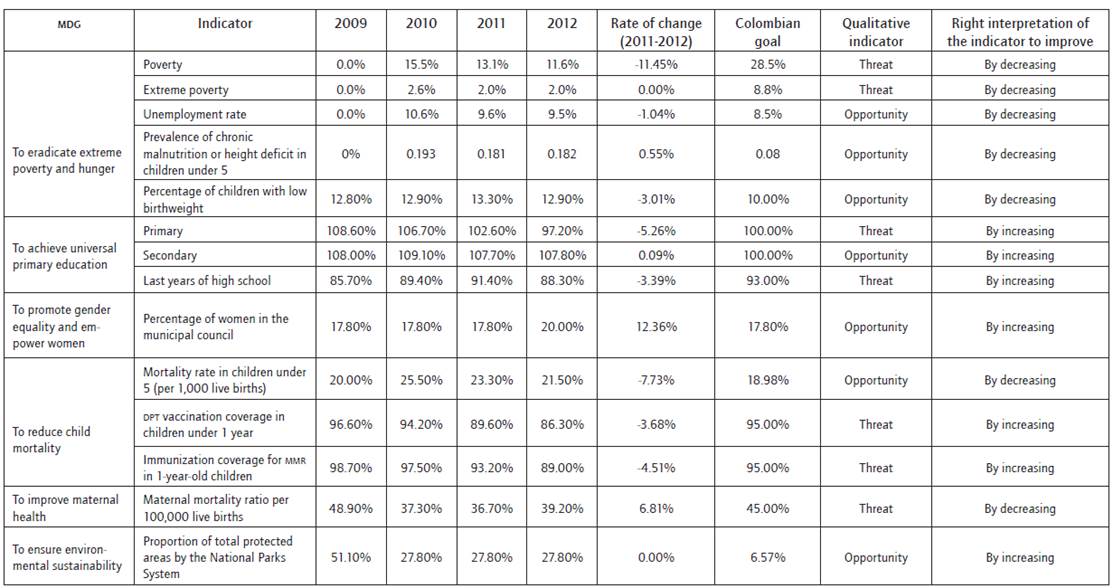
Source: Based on Niño-Muñoz (2016) and completed with information from Bogota city Mayor’s Office (Alcaldía Mayor, 2013).
Table 2 GRI Indicators.
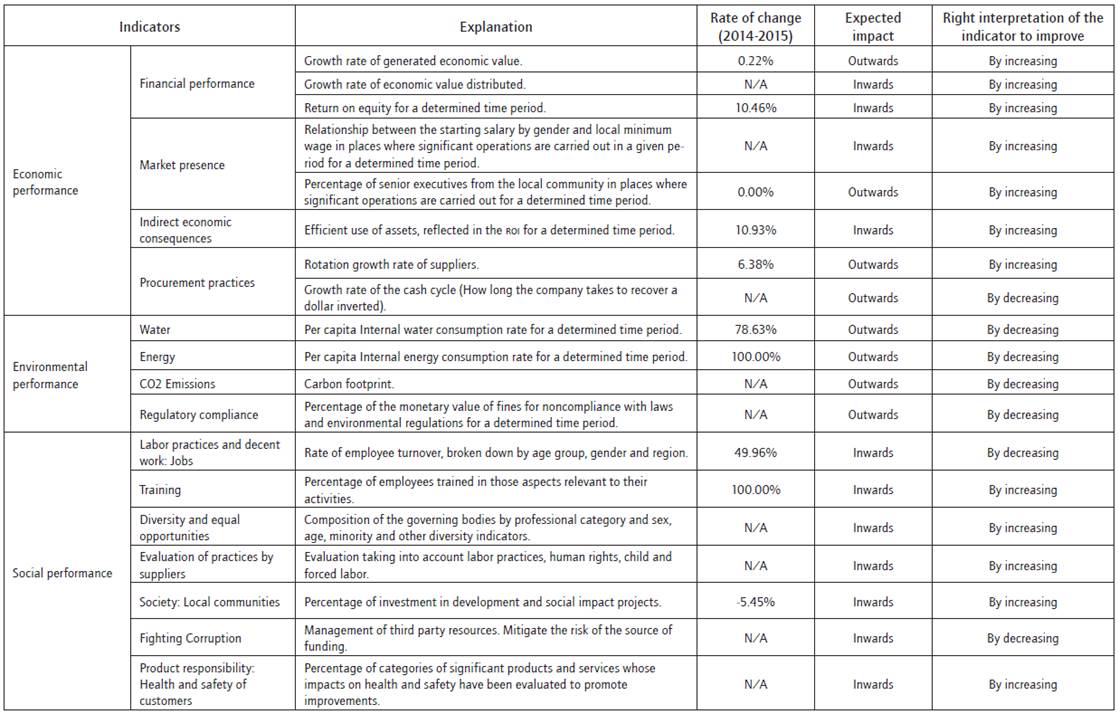
Source: Based on Niño-Muñoz (2016) and complemented with information from Sergio Arboleda University.
As the methodology explains, in order to build the MORE it is necessary to calculate the performance of the territory regarding MCDS and the performance of the company regarding CRI reports (Niño-Muñoz, 2016). First, each selected MDC must be evaluated versus their relationship with the National Goal (NC). Therefore, the NC should become the x axis of the MORE. Then, if MCDi > NC, Bogotá has achieved a good performance and will be placed in the upper quadrants. Otherwise, if MCDi < NC, the city will be ranked in the lower quadrants. On the other hand, it is important to correctly interpret each CRI indicator. For example, when the energy consumption per capita or the infant mortality rates increase it represents a negative impact on the environment and the society. In these cases, the variation rate must be preceded by a minus sign.
In order to complete the MORE each MDC must be evaluated according to its evolution during the last two years based on the available information for Bogotá. As the methodology describes, if the MDC indicator improves it offers an opportunity for Bogotá and will be placed in the second quadrant. But, if it worsens, it will represent a threat and will be ranked in the first quadrant. On the other hand, CRI indicators must follow the analysis of the inward or outward impact of the organization (which is established in table 2). If the university presents an outward impact, this indicator must be placed at the left side of the figure; but if it is an inward impact, this indicator will be ranked at the right side. With the region's and the University's information we built the MORE presented in graph 1.
Graph 1 indicates the areas in which the University can appropriately intervene. In the first quadrant, any company has the possibility to intervene in areas with the presence of threats in the region. This quadrant must be the first one to be examined in terms of its relationship with the University's core business. However, if there is no relation to the core business, then we can analyze the second quadrant, as the company has a positive performance in both of them (first and second). In the other quadrants the University doesn't have the capacity to get involved. In this case, as the first and second quadrants indicate, it is possible to identify the following areas of intervention:
Threats against maternal mortality in the territory.
Opportunity to contribute to the reduction of extreme poverty.
Opportunity to contribute to the reduction of poverty.
Opportunity to contribute to the improvement of secondary education.
Opportunity to contribute to the sustainable environment in the territory.
Opportunity to contribute to gender equality in the territory.
Presence of the University in the local market.
High performance in training personnel in the activity carried out by the University.
Good performance in the efficient use of assets, reflected in the ROA.
With these areas in mind, this study stated that the best area for the University to intervene is the opportunity to contribute to the improvement of secondary education. Improving education at that level could also positively impact poverty, gender equality, sustainable environment, and conflict risk. In order to identify the University's real alternatives it is important to establish a diagnosis of the problems surrounding school level education in Bogotá. For this purpose, our study gathered the experiences of a group of district school teachers (see appendix 1) and a related research study (Osorio, Martínez, Gaviria, Montealegre, & Pedraza 2011). Using this diagnosis, we built the problem and objectives trees.
Prioritization of Alternatives through the Goals and Needs Tree (M&N Tree)
In order to build the problem tree (figure 1), the selection of a mean problem derivative of the more analysis is required. In this case, it is essential to understand the diagnosis of school education in Bogota to identify the problem. This diagnosis was built with information of the experiences of different schools teachers and took into account other stakeholders perceptions. After this analysis we could establish that the main problem is the deterioration of the teaching and learning process in public and private schools in Bogotá. The diagnosis and the knowledge of the authors allows for the identification of a cause-effect rationale, where the roots of the problem tree are the causes and its branches represent the effects of the main problem.
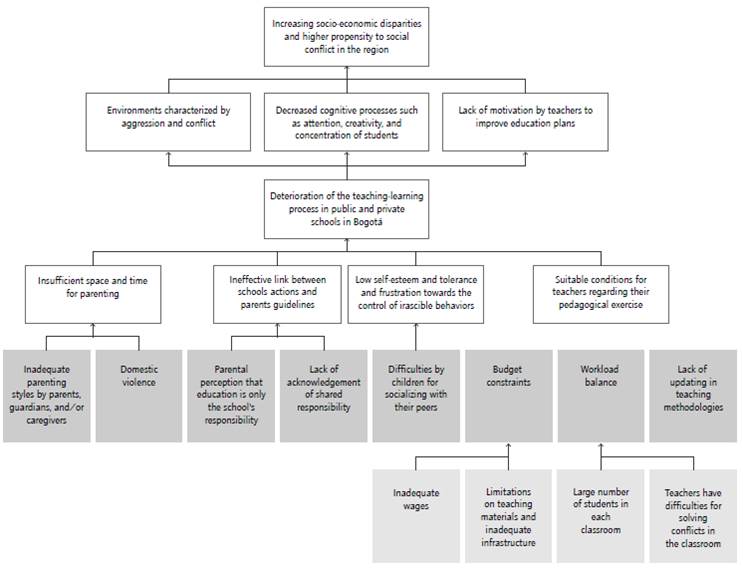
Source: Own elaboration.
Figure 1 Problem tree around the alternative of contributing to the improvement of school education.
The problem tree is transformed into an objectives tree by restating the problems as objectives [...] [it is] the positive mirror image of the problem tree [...] The objectives tree can also be considered as an 'ends - means' diagram. The top of the tree is the end that is desired and the lower levels are the means to achieving the end (Jackson, 1997, p. 8).
The objectives tree is presented in figure 2.
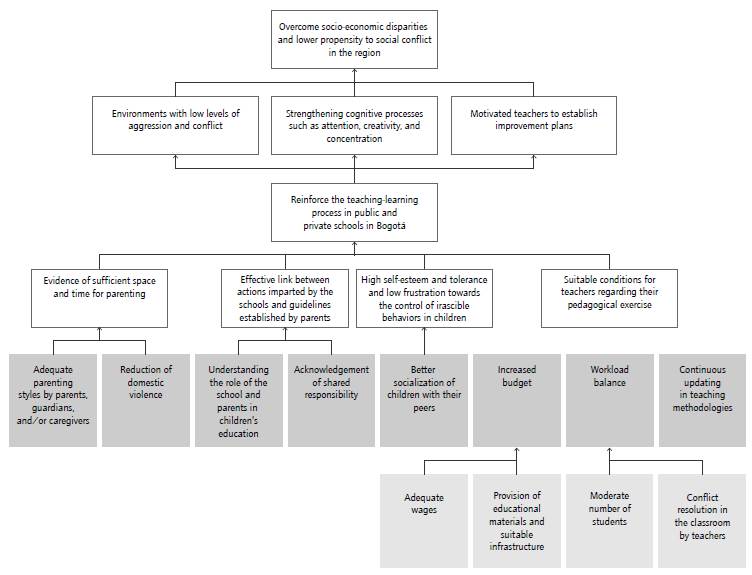
Source: Own elaboration.
Figure 2 Objectives tree around the opportunity to contribute in the improvement of school education.
Based on the diagnosis, it was possible to build the problem tree and the objectives tree. By analyzing the roots of the objectives tree (means) we identified the following alternatives, which are consistent with the University's core business:
Alternative 1: Support initiatives to provide a set of educational parenting and co-responsibility guidelines to parents of public or private schools in Bogotá.
Alternative 2: Support initiatives to strengthen the emotions of students in public or private schools in Bogotá.
Alternative 3: Methodological support to upgrading teachers in public or private schools in Bogotá.
Using AHP methodology to prioritize, Saaty (2008) explains that it requires of the following steps: (i) Problem statement; (ii) Building the hierarchy tree; (iii) Building comparison matrices with a set of pairwise; (iv) Obtaining the global priority. After the diagnosis we built the Goals and Needs Tree, which "structures the decision hierarchy from the top with the goal of the decision, then the objectives from a broad perspective, through the intermediate levels (criteria on which subsequent elements depend) to the lowest level (which...is a set of the alternatives)" (Saaty, 2008, p. 85). At the top of this tree, the main goal is to contribute to achieving the company's development by taking into account the peace process and the need for reducing regional gaps in Colombia. As observed in figure 3, the lowest level includes the three alternatives before identified, following the objectives tree.
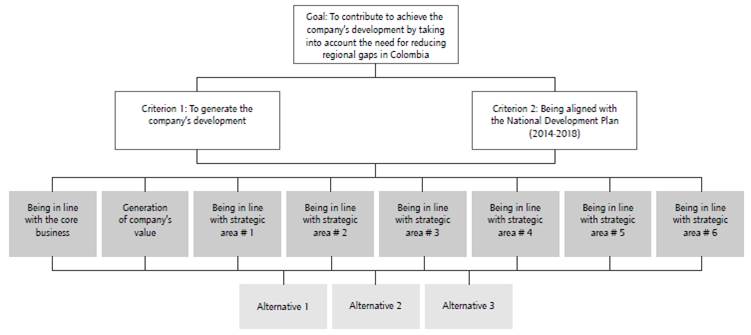
Source: Niño-Muñoz (2016), based on Nuñez, Aranda, & Bello (2015).
Figure 3 Goals and Needs Tree (M&N Tree).
In the intermediate levels the first criterion is to generate development for the company, which is divided into: being in accordance with the core business and the generation of company value. The alignment with the National Development Plan (NDP) and with each of its strategic areas is the second criterion. Santos administration NDP, called "Everyone for a New Country", included six strategic guidelines: (i) Competitiveness and Strategic Infrastructure; (ii) Social Mobility; (iii) Transformation of the Countryside; (iv) Security, Justice and Democracy for Peacebuilding; (v) Good Governance; and (vi) Green Growth. To understand the scope of each area, table 3 summarizes their elements.
The third step requires the construction of matrices to compare a set of pairwise. As suggested by stakeholder theory, the filling out of these matrices should be participatory, incorporating the academic community and the organization's stakeholders. This process supports the validation of our results. Thus, in order to complete each matrix, the AHP recommends taking in account the perspective of all stakeholders by collecting information through a representative sample. Although it is necessary to ensure the representativeness of the sample, the budgetary constraints of this study did not allow the application of such sample. We tried to solve this limitation by preparing a questionnaire for a representative member of each of the University's stakeholders. The stakeholders included a senior director, a member of the research area, a professor, an alumni, a student, and a colleague with constant contact with schools in Bogotá (see appendix 3). There are other participatory methodologies that researchers could follow to understand stakeholders' perception (Cohen & Martínez, 2004; Howaldt & Schwarz 2010; Martí-Olivé 2002; Moreno, Agirregomezkorta, & Cuadrado 1999).
For those interviews, we explained to the representatives of the stakeholders that the comparison between two elements "need[s] a scale of numbers that indicates how many times more important or dominant one element is over another element with respect to the criterion or property with respect to which they are compared" (Saaty, 2008, p. 85). Table 4 shows Saaty's intensity of importance scale.
In this case, we present eleven matrices to compare each element (see appendix 2). The first matrix compares the two main criteria; the second associates the sub-criteria of achieving the company's development; and the third compares the sub-criteria of contributing with the NDP. The other eight matrices are the combination of the different sub-criteria with each of the alternatives identified in the base of the tree. "Each element in an upper level is used to compare the elements in the level immediately below with respect to it" (Saaty, 2008, p. 85).
Finally, to prioritize the alternatives through the M&N Tree, each matrix must calculate its weighed values and the global priority; table 5 shows this information:
Use the priorities obtained from the comparisons to weigh the priorities in the level immediately below. Do this for every element. Then for each element in the level below add its weighed values and obtain its overall or global priority. Continue this process of weighing and adding until the final priorities of the alternatives in the bottom most level are obtained (Saaty, 2008, p. 85).
In this case, alternative 3 was prioritized. It refers to a methodological support to upgrading teachers in public or private schools in Bogotá.
CSR Strategies Design
Finally, it is important to design a CSR strategy. For this purpose, the main goal of the objectives tree and the subsequent prioritized alternative must be explicitly stated at the heart of the RedH's Canvas (table 6). The results of the entire process are summarized on the canvas. The life cycle of the university service used to determine its best CSR strategy is included at the right side of the canvas. This cycle is composed of the following elements: design, transformation, operation, and improvement. The beneficiaries are located also in this side, because the life cycle must be rethought considering this group of stakeholders. At the left side, the university can design its strategy by taking into account their own resources and their possible key partners. At the bottom, the firm must recognize their funding sources and the information required to evaluate new strategies.
The prioritized alternative was to promote methodological support spaces to upgrade the skills of public or private school teachers in Bogotá, taking advantage of the experience of the university in this area. As part of the strategy, RedH's canvas allows to understand that it is necessary to establish framework agreements with private schools associations and the district secretary of education to establish a direct communication channel with schools. Likewise, to achieve the main objective, the University must strengthen the study on education methodologies, making use of the knowledge generated by its research groups in education sciences. Finally, once these conditions are met, it is necessary to design and conduct a workshop in the selected schools to support the process of teachers updating. It is important to highlight that the University must implement a monitoring and evaluation system before, during, and after the workshop to measure the impact of its intervention. In this way, this paper reveals that Sergio Arboleda University can contribute to the achievement of human development objectives in the city by implementing a set of practices within a strategy, based on its capabilities, and taking into account the needs of Bogotá.
Conclusions and Recommendations
This paper presents the application of a holistic methodology to identify SRS. It follows a humanistic vision and, at this time, it is possible to consider Millennium Development Goals (MDC) as a reference for human development in the territory. The inclusion of the MDCS, and the possibility of including New Sustainable Goals, is especially important in view of the efforts made in Colombia to achieve development. This methodology facilitates the understanding of the company's environment and its interaction with business performance. It also identifies the best alternative for the organization to contribute to the regional development of the country. It was also crucial for SRS design and facilitating stakeholders' participation, especially in the diagnosis and prioritization of alternatives through M&N tree.
According to previous studies found in literature, this methodology meets the basic requirements of SRS, namely: stakeholder theory, a participative methodology, and being aware of inside-out and outside-in linkages between business and society. It articulates different instruments according to the capabilities of a firm towards Colombian peacebuilding and development processes. The main outcome is that the proposed method presents an efficient path for the design of a CSR strategy in a private higher education institution. However, we recommend to keep in mind some important issues for a better application.
First, the company must be committed to a series of information process regarding their CSR practices. At the beginning of this research it was very difficult to find companies which allowed the use of their information. Therefore, we chose international companies with whom we already had a relationship; or those we had previously worked with on CSR issues. However, in most of them, the main reason for denying the use of information was its unavailability. Even when analyzing the University's case it was difficult to compile all the required information. For the variety of cri indicators we could only obtain information on ten. This reduction implies that the methodology has a narrow scope regarding the University's capacity.
Second, due to budgetary constraints, it was not possible to obtain a representative sample of all stakeholders as a condition to build the M&N Tree. Nevertheless, we consider that this troublesome situation could be solved using any participative methodology; for example, through interviews with institutional representatives. This process does not need to be statistically representative. It is only necessary to select people who effectively represent the different interests around a specific problem (Martí-Olivé, 2002). However, for future research studies on the field, it is essential to include stakeholders from other regions where the firm operates. Despite the fact that we interviewed different individuals with certain knowledge about the other campus, the perception of needs by locals may differ from one region to another. In this sense, and given the budgetary restrictions faced by a company, national meetings are the perfect space to capture regional perspectives.
Third, we note some missing explanations in the applied methodology, focused on two points: (i) the definition of the final effect in the problem tree, and (ii) the awareness of the designed SRS. Regarding the first point, if the aim is to contribute to the peace process, the diagnosis must be centered towards this aspect. For this reason, after the implementation of the problem tree we realized that the final effect, at the top of the tree, must refer to a dimension related with the current context of the Colombian internal conflict; therefore, the problems surrounding the deterioration of the teaching-learning process will eventually have a negative impact in socio-economic disparities and likely to derive in social conflicts within the region. As far as the second point is concerned, to validate the proposed strategy it is necessary to add a final step of the methodology: an awareness stage. Although stakeholders were involved from the beginning, the awareness stage increases the possibility of having positive experiences from collaboration on the implementation of SRS. Moreover, it would help empower beneficiaries to achieve the main objective of the CSR strategy.
Finally, before using this methodology we recommend the company to: (i) strengthen and measure its internal practices; (ii) develop awareness of the importance of CSR; and (iii) be enthusiastic about contributing to the country's development.













